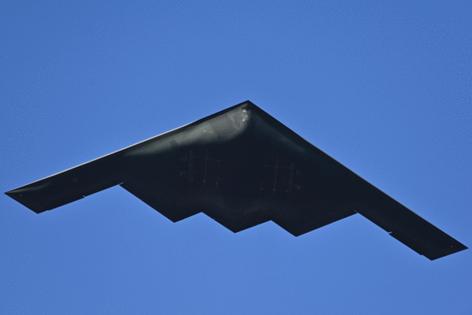US attack against Iran hinged on misdirection and decoys
Published in News & Features
The U.S. strikes that targeted Iran’s nuclear sites involved a decoy mission aimed at drawing attention from flight trackers while the largest-ever deployment of B-2 stealth bombers delivered 30,000-pound bunker-buster bombs for the first time in combat.
The operation — dubbed “Midnight Hammer” — was detailed by top Pentagon officials on Sunday morning. They described an extensive operation that included 125 aircraft overall, strikes by Tomahawk missiles launched from a U.S. submarine, and the use of 14 Massive Ordnance Penetrator bombs.
The heart of the 37-hour operation was a feint in which a group of B-2 bombers flew west across the Pacific Ocean as decoys to maintain tactical surprise, according to Defense Secretary Pete Hegseth. News reports on Saturday morning that picked up on flight-tracker data suggested those planes were being deployed as a way to strong-arm Iran into fresh talks on its nuclear program.
While those planes got all the attention, another group of B-2s flew east carrying the bunker-busters. The officials said dozens of air-refueling tankers, a guided missile submarine, and fourth- and fifth-generation fighters were involved in the attack, which struck nuclear strikes at Fordow, Isfahan and Natanz.
The briefing helped explain other data points that emerged in recent days, including a massive move by midair refueling tankers last week that was widely reported at the time. The White House had promised on Thursday that President Donald Trump would make a decision on a strike “within two weeks,” suggesting there might be more time.
In the end, the Saturday night operation was deemed a success by the Pentagon. No U.S. servicemembers were lost, and Iran didn’t fire at any of the U.S. military assets, according to the officials. Hegseth said members of Congress were only notified after the planes were out of danger, contradicting earlier reports that Trump had informed Republican congressional leadership beforehand.
The flights to deliver the targets amounted to the second-longest flights in the B-2’s operational history, according to Hegseth and Air Force General Dan Caine, the chairman of the Joint Chiefs of Staff. The longest was a 40-hour round trip in October 2001 in the initial phase of the Afghanistan war.
“This is a plan that took months and weeks of positioning and preparation, so that we could be ready when the president of the United States called,” Hegseth said. “It took a great deal of precision. It involved misdirection and the highest of operational security.”
The officials said 75 precision-guided weapons were used and the operation involved some 125 aircraft. Caine said the battle damage would take time to assess but “all three sites sustained extremely severe damage and destruction.”
Prior to the B-2 strikes on Fordow, a submarine with the Carl Vinson Carrier Strike Group in the Arabian Sea fired 24 Tomahawk cruise missiles, according to Caine and a graphic released by the Pentagon.
Addressing the nation late Saturday, Trump said Iran’s “key nuclear enrichment facilities have been completely and totally obliterated.”
“It would not be a surprise to me if, after an assessment period, we went back in and re-struck some of these targets to make sure that we achieved the effect,” said Joseph Votel, a former commander of the U.S. Central Command and now a fellow at the Middle East Institute. “That actually is a normal part of our military targeting process, is to strike, assess, and then if necessary, strike again to achieve the results that we’re looking for.”
Hegseth said the mission was focused on destroying Iran’s nuclear program and not regime change in Tehran. “The mission was not, has not, been about regime change,” he said.
But Secretary of State Marco Rubio made clear that Iran needs to clearly abandon its nuclear weapons ambitions.
“At the end of the day, if Iran is committed to becoming a nuclear weapons power, I do think it puts the regime at risk,” Rubio said Sunday on Fox News. “I really do. I think it would be the end of the regime if they tried to do that.”
While the damage assessments are still coming in, U.S. Vice President JD Vance said he’s confident the U.S. strikes on Iranian sites “have substantially delayed their development of a nuclear weapon — and that was the goal of this attack.”
Iran’s nuclear program has been pushed back “by a very long time,” he said in an interview with NBC’s "Meet the Press." “I think that it’s going to be many, many years before the Iranians are able to develop a nuclear weapon.”
_____
(With assistance from Eric Martin, María Paula Mijares Torres and Natalia Drozdiak.)
_____
©2025 Bloomberg L.P. Visit bloomberg.com. Distributed by Tribune Content Agency, LLC.







Comments